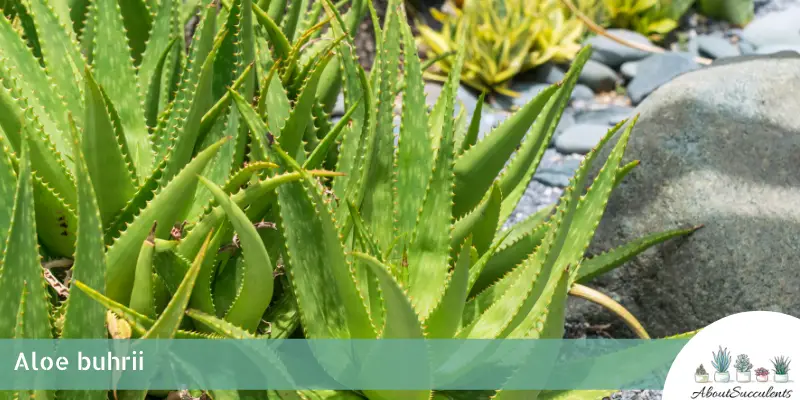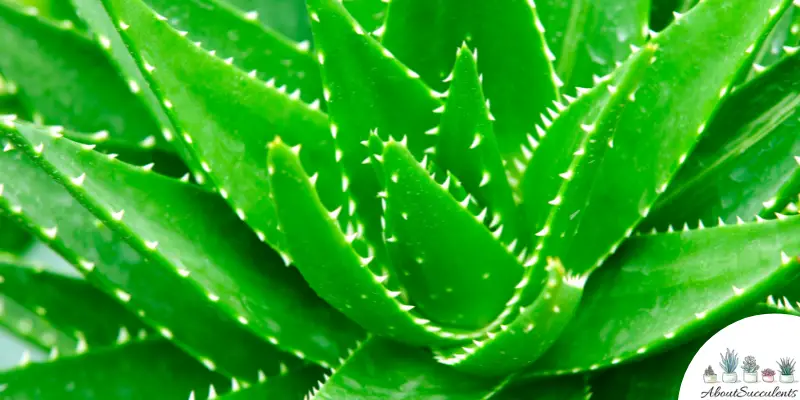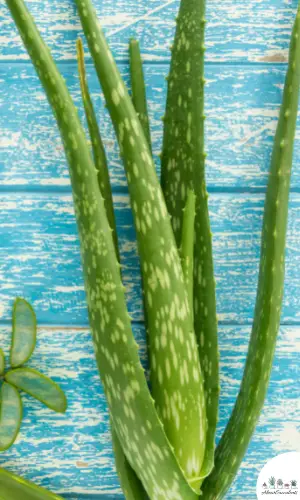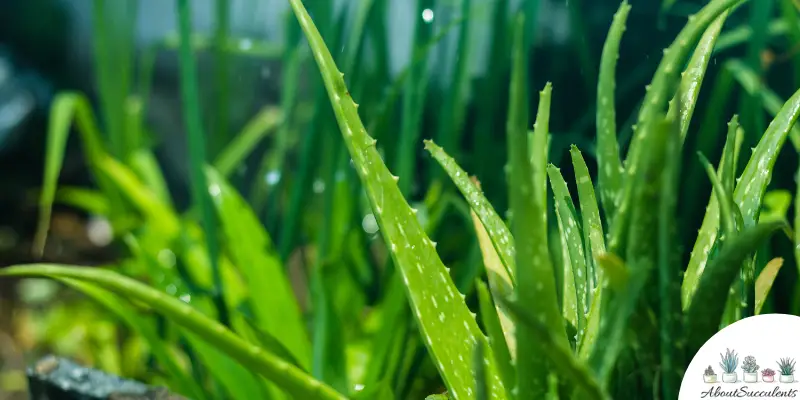
Aloe Buhrii has long, smooth, rubbery, leaves with red-margined leaves that are accented with striations running lengthwise. These 16-inch (40cm) long leaves give Aloe Buhrii a bewildering type of beauty that excites many succulent growers and landscape artists.
Also known as “Spotted Aloe” and “Elias Buhr’s Aloe”, these lance-shaped leaves are pale-green with barely visible teeth on the edges. When the plant matures, the leaves develop a purplish hue dotted with H-shaped white spots.
The stemless rosette grows up to 21-inches (61 cm) tall and 36-inches (91 cm) wide. In Spring, Aloe Buhrii produces eye-catching multi-branched inflorescence of orange or yellow blossoms. Hummingbirds are highly-drawn to these flowers.
The Spotted Aloe is native to South Africa. It is part of the Aloe genus from the Asphodelaceae family.
General Information
Also known as: Spotted Aloe, Elias Buhr’s Aloe
Plant Family: Asphodelaceae
Origin: South Africa
Height: 24-inches (61 cm)
Exposure: Full Sun to Partial Shade for up to 6 hours every day. Avoid the mid-afternoon sun as the harsh rays will burn the leaves.
Water Needs: Low Water Needs; use the ‘soak and dry’ watering method
Soil Type: Fast-draining succulent soil combined with gritty materials such as perlite, pumice, coarse sand, and lava rocks.
Soil pH: 7.0 to 8.5
How to Grow and Care for Aloe Buhrii

Aloe Buhrii is a low-maintenance plant that can thrive well indoors or outdoors. With its bright hues and lovely inflorescence, the Spotted Aloe will perfectly blend in any xeriscape or container garden. It will also make an eye-catching potted indoor decoration.
The Spotted Aloe is not cold-hardy and cannot survive at temperatures below -1.1°C (30°F). If you live in an area with freezing temperatures, it is best to pot your plant so you can move it indoors during winter.
Sunlight
If you will grow your Spotted Aloe outdoors, plant it in an area where it can get at least 6 hours of full to partial sun. Aloes need plenty of bright light to grow vibrant and healthy.
As a homegrown plant, position the container near a South- or West-facing window where Spotted Aloe can get 6 hours of partial sunlight per day.
If your house does not have an area with sufficient natural light sources, get a full spectrum of artificial light. Place the LED grow light 6 to 12-inches (15.24 to 30.48cm) above your plant and keep it lit for 14 hours a day.
Without enough sunlight, Aloe Buhrii will experience etiolation, a condition where the plant’s leaves stretch out in search of light. You can address etiolation by slowly exposing Buhr’s Aloe to partial sunlight.
Watering

Watering your Aloe Buhrii correctly will keep it healthy and happy for a long time. Succulents are very vulnerable to overwatering because they have shallow roots.
Use the “soak and dry” watering technique to prevent the soil from getting waterlogged. With this technique, you water the soil thoroughly and let it completely dry out before you water it again.
Spotted Aloe actively grows during winter so you need to water the plant every 3 to 5 days or when the soil dries out. Increase your watering intervals during summer when your aloe plant enters its dormant phase.
Thus, when the months become colder, expect to water the soil less frequently. You might only give the soil water once a month during the winter.
Pot and Soil
Succulents grow well in terracotta and ceramic pots. These are made with breathable materials that allow proper water drainage and soil aeration. Always get pots with drainage holes and mesh net covers.
Choose a pot large enough to give your plant room to grow, but never settle for an oversized one. If the pot is too big for your succulent plant, the soil will hold more water and damage its fragile and shallow roots.
Get one that is 10% wider than the diameter of your Aloe Buhrii. The depth of your pot should also be 10% longer than the roots of your succulent. This will prevent the roots from overcrowding the pot.
For your potting soil, use the standard succulent mix combined with crushed limestone, coarse sand, perlite, or gravel. If potted, fertilize the soil when your Spotted Aloe is actively growing in winter.
Use a 10-40-10 succulent fertilizer mix. Water your plant thoroughly a day before feeding, to remove salt in the soil and the risk of tip burn. Do not feed your aloe with fertilizer during summer when it’s dormant.
How to Propagate Aloe Buhrii

You can reproduce Aloe Buhrii by using its leaf cuttings and offsets. The best time to propagate your succulent is during early spring to late winter.
Offsets Method
Step 1: Look for healthy pups at the base of the plant. If potted, remove the mother plant from the container and look for offsets with a few roots.
Step 2: Use a sterile sharp knife or pruning shears to cut the offset away from the mother plant. Gently brush off the soil from the roots.
Step 3: Leave the offset in a warm, shaded area for 2 to 3 days or until the cut ends callous.
Step 4: Once calloused, plant the offset in terracotta or a ceramic pot filled with cactus or succulent soil mix combined with gritty materials.
Step 5: Place the pot in a place where it can get plenty of indirect bright light. Do not water for a few weeks to allow the offset to develop roots and acclimate to its new home.
Leaf Cuttings Method
Step 1: Gently twist a healthy leaf off the base of the plant. You can also use a sterile sharp knife or pruning shears to make a clean cut.
Step 2: Leave the leaf in a shaded area for 3 to 4 days and allow the cut end to be callous.
Step 3: Plant the calloused leaf in a pot filled with cactus or succulent soil mix. Mist the soil sparingly while the leaf-cutting is developing roots.
Step 4: After a few weeks, gently tug the leaf-cutting. If you feel a slight resistance, it means your plant has rooted. Once rooted, mist the soil once every 2 to 3 days.
Frequently Asked Questions
Is Aloe Buhrii Toxic to Cats and Dogs?
Aloe Buhrii is not listed as toxic to cats and dogs on the website of the American Society for the Prevention of Cruelty to Animals (ASPCA).
Why Is My Aloe Buhrii Dying?
Aloes are tough plants but they will succumb to illness due to the following causes: Overwatering and pest infestation.
Overwatering
Root rot is the number one cause of succulent disease. When the soil gets waterlogged, the roots are damaged and the soil becomes a breeding ground for fungus.
You are overwatering your Aloe Buhrii when its leaves become mushy, the tips of its leaves turn brown, and molds start to grow in the soil. Reverse your plant’s unhealthy condition by acting quickly.
The first thing you have to do is to get a sterilized and sharpened knife and cut off all of the plant’s infected sections. Then, remove the plant from the pot. Brush off the soil from the roots. Cut off all the damaged roots with the knife or a pair of sterile sharp pruning shears.
Reminder: Always sterilize the cutting tool after every use because the blades might contain bacteria. Sterilize with 70% isopropyl alcohol.
Leave your Spotted Aloe in a warm, shaded area. Fill a terracotta pot with succulent soil mix combined with plenty of gritty materials.
Repot your aloe plant and wait four to five days before watering the soil. Repotting is traumatic to the plant so you need to give it time to acclimate to its new environment before watering it.
Pest Infestation
Aloes are prone to aphids and mealybugs infestation. These sap-sucking insects can cause irreversible damage to your Aloe Buhrii. You need to remove these pests as soon as you detect them.
The best indicator of aphids’ presence is ants on your Aloe. To detect mealybugs, look for white cottony waxy spots on the leaves or in crevices.
Isolate the affected plant. Spray all the leaves, leaf joints, the base of the plant, and edges of the pot with 70% rubbing alcohol or diluted neem oil. Use a cotton swab dipped in alcohol or neem oil to remove the mealybugs hiding in the crevices.
You can also spray your plant with 1 teaspoon of liquid soap mixed with 1 liter of water. It would take weeks to remove these pests. Repeat the treatment twice a week until you get rid of all the pests.
During treatment, place your pot in a shaded area. Do not expose your plant to direct sunlight to prevent sunburn.
To prevent reinfestation, repot your treated plant in a fresh soil mix. Make sure to disinfect the container before you use it again.
Yes, Aloe Buhrii produces orange or yellow flowers that adorn multi-branch stems in Spring.
Last Updated on June 9, 2022 by Sofia Lara